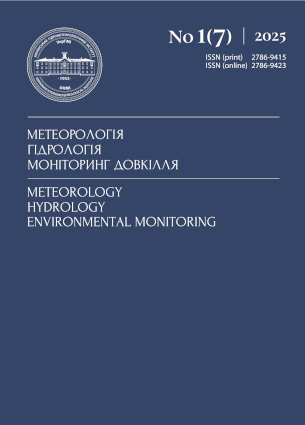SIMULATION OF RAIN FLOODS OF THE STRYI RIVER BY AN ARTIFICIAL NEURAL NETWORK
Ukrainian Hydrometeorological Institute of the State Emergency Service of Ukraine and the National Academy of Sciences of Ukraine, Kyiv
https://orcid.org/0000-0003-4290-3745
Liudmyla Gorbachova
Ukrainian Hydrometeorological Institute of the State Emergency Service of Ukraine and the National Academy of Sciences of Ukraine, Kyiv
https://orcid.org/0000-0003-1033-9385
Abstract
References
1. Aoulmi, Y., Marouf, N., & Amireche, M. (2021). The assessment of artificial neural network rainfall-runoff models under different input meteorological parameters. Case study: Seybouse basin, Northeast Algeria. Journal of water and land development, 50(VI–IX), 38–47. https://doi.org/10.24425/jwld.2021.138158
2. Belchikov, V.A., & Koren, V.I. (1979). Model of the formation of melting and rain runoff for forest catchments. Proceedings of the Hydrometeorological Center of the USSR, 218, 3–21. [in Russian]
3. Chakravarti, A., Joshi, N., & Panjiar, H. (2015). Rainfall Runoff Analysis Using Artificial Neural Network. Indian Journal of Science and Technology, 8(14), 1–7. https://doi.org/10.17485/ijst/2015/v8i14/54370
4. Cigizoglu, H.K. (2003). Estimation, forecasting and extrapolation of river flows by artificial neural networks. Hydrological Science Journal, 48(3), 349–361. https://doi.org/10.1623/hysj.48.3.349.45288
5. Ghumman, A.R., Ghazaw, Y.M., Sohail, A.R., & Watanabe K. (2011). Runoff forecasting by artificial neural network and conventional model. Alexandria Engineering Journal, 50, 345–350. https://doi.org/10.1016/j.aej.2012.01.005
6. Gopchenko, E.D., & Goptsiy, M.V. (2015). Maximum runoff of rain floods in the Carpathian Mountains: monograph. Odesa: TES. [in Ukrainian]
7. Guide to Hydrological Practices (2009). Management of Water Resources and Application of Hydrological Practices. Vol. II. Sixth edition. WMO-No. 168. Geneva: World Meteorological Organization.
8. Hornik, K., Stinchcombe, M., & White, H. (1989). Multilayer feedforward networks are universal approximators. Neural Networks, 2(5), 359–366. https://doi.org/10.1016/0893-6080(89)90020-8
9. Khrystiuk, B., Gorbachova, L., & Shpyg, V. (2022). Verification of the automated flood forecasting system on the Stryi River. Acta Hydrologica Slovaca, 23(2), 234–240. https://doi.org/10.31577/ahs-2022-0023.02.0026
10. McCulloch, W.S., & Pitts W. (1943). A Logical Calculus of the Ideas Imminent in Neural Activity. Bulletin of Mathematical Biophysics, 5, 115–133. https://doi.org/10.1007/BF02478259
11. Minns, A.W., & Hall, M.J. (1996). Artificial neural networks as rainfall-runoff models. Hydrological Science Journal, 41(3), 399–417. https://doi.org/10.1080/02626669609491511
12. Mohseni, U.; Muskula, S.B. (2023). Rainfall-Runoff Modeling Using Artificial Neural Network–A Case Study of Purna Sub-Catchment of Upper Tapi Basin, India. Environmental Sciences Proceedings, 25, 1. https://doi.org/10.3390/ECWS-7-14232
13. Nash, J.E., & Sutcliffe, J.V. (1970). River flow forecasting through conceptual models, part1 – a discussion of principles. Journal of Hydrology, 10(3), 282–290. https://doi.org/10.1016/0022-1694(70)90255-6
14. Operational Hydrology Manual (2012). Forecasts of the Land Water Regime. Hydrological Support and Maintenance. Kyiv: Verlan Publishing House. [in Ukrainian]
15. Pryimachenko, N.V. (2010). Substantiation of the system for calculating flood characteristics on mountain rivers of the Dniester basin based on mathematical modeling of rain runoff formation processes. Аvtoref. dys. ...kand. geogr. nauk: 11.00.07. Taras Shevchenko National University of Kyiv. [in Ukrainian]
16. R Core Team (2017). A language and environment for statistical computing. R Foundation for Statistical Computing. Vienna, Austria. Available at: https://www.r-project.org
17. Riad, S., Mania, J., Bouchaou, L., Najjar, Y. (2004). Rainfall-runoff model usingan artificial neural network approach. Mathematical and Computer Modelling, 40(7-8), 839–846. https://doi.org/10.1016/j.mcm.2004.10.012
18. Ripley, B.D. (1996). Pattern Recognition and Neural Networks. Cambridge University Press.
19. Rosenblatt, R. (1959). Principles of Neurodynamics. New York: Spartan Books.
20. Shamseldin, A.Y. (1997). Application of a neural network technique to rainfall–runoff modeling. Journal of Hydrology, 199(3-4), 272–294. http://dx.doi.org/10.1016/S0022-1694(96)03330-6
21. Sosedko, M.N. (1976). Forecast of the course of rain runoff on the mountain rivers of the Dniester basin, taking into account the unevenness of the inflow. Proceedings of UkrNIHMA, 143, 132–147. [in Russian]
22. Sosedko, M.N. (1984). Develop recommendations and requirements for the flood forecasting subsystem project of ASUB Stryi: report on research. Kyiv: Ukrainian Regional Research Institute. [in Russian]
23. Susidko, М.М. (2000). Mathematical modeling of runoff formation processes as a basis of forecasting systems. Hydrology, Hydrochemistry and Hydroecology, 1, 32–40. [in Ukrainian]
24. Tayfur, G. (2002). Artificial neural networks for sheet sediment transport. Hydrological Science Journal, 47(6), 879–892. https://doi.org/10.1080/02626660209492997

